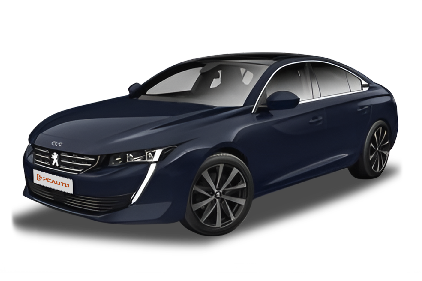Q
How big is the boot on a Peugeot 508?
The trunk of the Peugeot 508 has a volume of approximately 487 liters. This space is more than enough to meet the daily needs of most families. For example, you can easily place suitcases, shopping bags, or other large items in it. For users in Malaysia, this capacity is highly suitable for storing things during weekend getaways or long - distance trips.
The trunk is designed quite regularly, and the opening is wide enough, which makes it convenient to load and unload items. Meanwhile, the rear seats can be folded down in a split ratio, further expanding the storage space and offering high flexibility. In addition, the trunk of the 508 is equipped with useful hooks and straps, which are handy for securing fragile or slippery items.
In Malaysia's hot and rainy climate, the trunk's sealing performance and durability are also commendable. It can effectively protect items from being affected by moisture or high temperatures. If you need more storage space, you can consider adding a roof box. However, be aware that this may slightly increase fuel consumption and wind noise.
Overall, the trunk design of the Peugeot 508 combines practicality and convenience, and can meet the daily usage scenarios of most Malaysian users.
Special Disclaimer: This content is published by users and does not represent the views or position of PCauto.
Related Q&A
Q
How many cylinders is a Peugeot 508?
Sorry, I haven't found the specific information about the number of cylinders of the Peugeot 508. Generally speaking, for D-class sedans like the Peugeot 508, the engines commonly equipped usually have 4 cylinders. A 4-cylinder engine can strike a good balance between power and fuel economy, meeting the needs of daily driving and certain power requirements. If the vehicle is equipped with turbocharging technology, it can also improve the power output to a certain extent. However, to know the exact number of cylinders of the Peugeot 508, it is recommended to check the vehicle's official manual or consult an authorized Peugeot dealer, as they can provide accurate and detailed technical parameter information about this vehicle.
Q
Is the Peugeot 508 a big car?
The Peugeot 508 belongs to the mid-sized sedan category (D-segment) in the Malaysian market. Its body dimensions are 4.75 meters in length, 1.86 meters in width, and 1.42 meters in height, with a wheelbase of 2.79 meters. Compared with traditional Class B sedans like the Honda Accord or Toyota Camry, it's slightly shorter in wheelbase but similar in width, and it's a European mid-sized car with a more sporty design. Although its fastback styling sacrifices some rear-seat headroom, the trunk volume reaches 487 liters. Paired with frameless doors and a low roofline, it looks more sleek and dynamic visually.
In the Malaysian road environment, the size of the 508 is suitable for city driving. It has better maneuverability in narrow alleys than real large-sized sedans (E-segment), yet still offers excellent stability on the highway. Competitors in the same class, such as the Volkswagen Passat or Mazda 6, have similar dimensions. However, the 508 improves space utilization through its i-Cockpit design. The driver's seat visibility and storage compartment layout are more suitable for Asian body types.
It should be noted that Malaysian consumers who often need to carry five adults on long-distance trips are advised to actually experience the rear-seat knee room. After all, European models focus more on the front-seat driving and riding experience. The handling flexibility of the 508 will show its advantages in the old cities of Penang or Kuala Lumpur. Meanwhile, its active safety systems like lane-keeping can also adapt to the complex road conditions in Malaysia.
Q
Is the Peugeot 508 petrol?
Yes, the Peugeot 508 is available with a gasoline engine version in the Malaysian market. Specifically, it is equipped with a 1.6-liter PureTech turbocharged gasoline engine. This engine is well-known for its high efficiency and low emissions. It can deliver a maximum output power of up to 165 horsepower and is paired with an 8-speed automatic transmission, offering a smooth driving experience.
As a mid-sized sedan, the Peugeot 508 not only focuses on power performance but also features a stylish exterior design and luxurious interior configuration. It is suitable for Malaysian consumers who pursue driving pleasure and comfort. Moreover, the 508 is also equipped with advanced driving assistance systems, such as adaptive cruise control and lane - keeping assist, which enhance driving safety.
In Malaysia, gasoline-powered cars remain the mainstream choice because of the well-developed gas station network and relatively stable gasoline prices. The gasoline version of the Peugeot 508 precisely meets this market demand. Meanwhile, its engine technology also complies with the current environmental protection trend, making it suitable for daily commuting and long-distance driving.
Q
How to charge a Peugeot 508?
Charging the electric Peugeot 508 (like the plug-in hybrid 508 Hybrid) is a breeze. First, make sure to park your vehicle in a safe and well-ventilated area. Then, use the charging cable that comes with the car. Plug one end into the vehicle's charging port (usually located at the rear side of the car body) and the other end into a household power supply (220V) or a public charging station. While charging, the dashboard will show the charging status and the estimated time to finish. It's recommended to use a dedicated charging station to boost efficiency and protect the battery life.
In Malaysia, the network of public charging stations is gradually improving. You can find nearby charging points through local platforms such as ChargeNation or JomCharge. Also, it's a good idea to regularly check if the charging equipment is in good condition and avoid using damaged cables. If you choose the fast-charging mode, it takes about 2 hours to reach 80% charge. However, long-term use of fast charging may affect the battery health, so it's better to rely on slow charging in daily use.
Moreover, Peugeot's battery management system can optimize the charging efficiency. Owners don't need to worry too much about over-charging. But pulling out the plug in time after charging can save energy. As for the fuel-powered Peugeot 508, you need to refill gasoline at a gas station, which has nothing to do with charging.
No matter which powertrain system your Peugeot 508 has, regular maintenance can ensure the best performance of the vehicle.
Q
Are Peugeot 508 expensive to insure?
In Malaysia, the insurance costs for the Peugeot 508 are generally slightly higher than those of ordinary Japanese or domestic models. This is mainly due to its positioning as a European mid-sized sedan, higher maintenance costs, and a relatively large proportion of imported parts. However, the specific insurance premiums still depend on the vehicle's age, engine specifications (such as 1.6T or plug-in hybrid versions), the owner's driving record, and the insurance company's policies. It is recommended that car owners compare quotes from different insurance companies before purchasing insurance and consider adding third-party fire and theft insurance for comprehensive protection.
In addition, the maintenance network for European cars in Malaysia is relatively limited, which may affect insurance assessments. But the Peugeot officially authorized maintenance centers can provide original parts and professional services, which helps to reduce the long-term maintenance risks. If the budget is limited, car owners can choose a higher excess to lower the insurance premiums. At the same time, regular vehicle maintenance to keep the car in good condition can also indirectly reduce insurance costs. The insurance costs of other European cars with similar positioning, such as the Volkswagen Passat or Skoda Superb, are also at a similar level. Car owners can make a comprehensive trade-off based on their personal needs.
Q
What is the fuel consumption of Peugeot 508?
The fuel consumption performance of the Peugeot 508 varies depending on the model and powertrain configuration. Take the 1.6-liter PureTech turbocharged gasoline engine version commonly seen in the Malaysian market as an example. Its combined fuel consumption is approximately 6.0 to 6.5 liters per 100 kilometers. The 2.0-liter BlueHDi diesel engine version is even more fuel-efficient, with a combined fuel consumption of 4.5 to 5.0 liters per 100 kilometers. The specific figures are also affected by factors such as driving habits, road conditions, and vehicle load. For Malaysian consumers, choosing the diesel version may offer better fuel economy during long-distance driving, while the gasoline version is more suitable for urban commuting. It's worth mentioning that the Peugeot 508 adopts advanced engine technology and lightweight design, which not only improves fuel efficiency but also reduces emissions, meeting the current environmental protection trend. If you're particularly concerned about fuel consumption, it's recommended to maintain smooth acceleration and deceleration during actual driving and regularly service your vehicle, such as checking tire pressure and replacing the air filter. These small tips can help further optimize fuel consumption performance.
Q
Is the Peugeot 508 electric?
Currently, the Peugeot 508 available in the Malaysian market is the traditional fuel-powered version, which includes a 1.6-liter turbocharged gasoline engine option. There is no all-electric vehicle model yet. However, Peugeot's parent company, the Stellantis Group, is actively promoting an electrification strategy. Electric vehicle models such as the e-208 and e-2008 have been launched in overseas markets, and it's expected that the 508 series will also get an electrified version in the future.
For Malaysian consumers, if they're considering European new energy vehicles, they can pay attention to all-electric models like the locally introduced BMW i4 and Mercedes-Benz EQE, or wait for Peugeot's future electric products in the Southeast Asian market. The Malaysian government encourages the popularization of electric vehicles through tax - exemption policies, but the charging infrastructure is still under construction. It's recommended to evaluate daily usage scenarios before buying a car. If short-distance commuting is the main need, plug-in hybrid models like the Peugeot 3008 PHEV can also be considered, which combines the convenience of fuel with partial all-electric driving capabilities.
Q
How many cc is a Peugeot 508?
The Peugeot 508 offers a variety of engine options in the Malaysian market. The specific engine displacement depends on the model year and version. Currently, the common petrol version is equipped with a 1.6-litre PureTech turbocharged engine with an actual displacement of 1,598 cc, which can output approximately 180 horsepower. The diesel version, on the other hand, is fitted with a 2.0-litre BlueHDi engine with a displacement of 1,997 cc, offering around 180 horsepower. In addition, Peugeot 508 also has a plug-in hybrid version, which combines a 1.6-litre petrol engine and an electric motor, with a combined system power of up to 225 horsepower.
For Malaysian consumers, when choosing a car's engine displacement, they need to consider their daily usage requirements. A small-displacement turbocharged engine is suitable for urban commuting, taking into account fuel economy. A larger displacement engine is more suitable for long-distance driving or for those who pursue better power performance. The diverse power configurations of the 508 can meet different driving preferences.
Meanwhile, Malaysia's road tax system is graded based on engine displacement. It is recommended to understand in detail the road tax costs corresponding to each displacement before buying a car, so as to make a more cost-effective choice.
Q
What kind of engine is in the Peugeot 508?
The Peugeot 508 offers a variety of powertrain options in the Malaysian market, including efficient petrol and diesel engine versions. The petrol engine is mainly a 1.6-liter PureTech turbocharged engine, which delivers 180 horsepower and 250 Nm of torque. It's paired with an 8-speed automatic transmission, balancing power and fuel economy. The diesel version, on the other hand, is equipped with a 2.0-liter BlueHDi engine, which has stronger torque output and is suitable for long-distance driving.
In addition, the Peugeot 508 also offers a plug - in hybrid electric vehicle (PHEV) version. It combines a 1.6-liter petrol engine with an electric motor, with a combined output of up to 225 horsepower. It has an all-electric range of about 50 kilometers, making it a great choice for environmentally-conscious consumers.
Peugeot's engine technology focuses on low emissions and high efficiency, meeting the global environmental protection trend. Meanwhile, its driving experience leans towards comfort and precise handling, which is suitable for the diverse road conditions in Malaysia.
For readers who want to know more about engine technology, they can focus on how turbocharging and hybrid systems enhance performance and energy-saving. These technologies are becoming more and more popular in the current automotive industry.
Q
Does a Peugeot 508 have a timing belt or chain?
The Peugeot 508 has adopted different timing drive designs according to different years and engine models. The early 1.6-liter and 2.0-liter diesel engine versions usually use a timing belt, while the 1.6-liter THP gasoline engine versions launched in recent years have switched to a timing chain. These two designs each have their own advantages and disadvantages. The timing belt has a lower cost but needs to be replaced regularly (usually every 60,000 to 100,000 kilometers). On the other hand, the timing chain is more durable and basically maintenance-free, but it may be a bit noisier. Malaysian car owners should refer to the vehicle manual or consult an authorized service center to confirm the specific configuration of their vehicles. By the way, I'd like to remind everyone that regular inspections are very important regardless of which timing system is used, because once a failure occurs, it may cause serious damage to the engine. Additionally, in the hot and humid climate of Malaysia, the rubber timing belt will age faster, so it's even more necessary to strictly follow the maintenance schedule for inspections and replacements.
Latest Q&A
Q
How much is a new Toyota Yaris 2025?
The all-new 2025 Toyota Yaris is expected to hit Malaysian showrooms with a price tag ranging from RM 70,000 to RM 90,000, though the final figure will depend on the trim level and any optional extras you tick. The base model will likely stick with the tried-and-tested 1.5L naturally aspirated engine paired with a CVT gearbox, while higher-spec variants should come loaded with more safety tech, including the Toyota Safety Sense suite – think pre-collision warning and lane-keeping assist, for starters.
In the local B-segment hatchback scene, the Yaris has always been a hit thanks to its fuel efficiency, reliability, and nimble handling. What sets it apart from rivals like the Honda City Hatchback or Nissan Almera? A sportier exterior design that gives it a bit more attitude.
But hey, don’t forget to factor in extra costs like road tax, insurance, and registration fees when budgeting – those can add up. Your best bet? Swing by an authorized Toyota dealer to check out the latest promos. Toyota Malaysia often runs deals like low-interest financing or free service packages, which are definitely worth asking about.
Oh, and keep an eye out for the 2025 model’s upgraded infotainment system – rumor has it wireless Apple CarPlay and Android Auto might finally make the cut, making your daily drive that much more convenient.
Q
How much horsepower does a 2025 Toyota Yaris have?
Toyota hasn't officially spilled the beans on the exact horsepower figures for the 2025 Yaris in Malaysia just yet. But if we take a peek at the current model's powertrain setup, it's a safe bet we'll still see the 1.5-liter four-cylinder naturally aspirated engine making a return. We're probably looking at around 106 to 110 horsepower, paired with that trusty CVT gearbox – perfect for zipping around the city and keeping fuel costs in check.
Now, if they decide to bring in the GR Sport performance trim, that's where things could get interesting. Word on the street is it might pack a punch with a 1.6-liter turbocharged engine, potentially cranking out over 200 horsepower. But hey, don't hold me to that until Toyota Malaysia makes it official, right?
Here's the thing though – horsepower isn't the be-all and end-all when it comes to a car's performance. Torque delivery, how light the body is (thanks to the TNGA platform the Yaris uses), and how efficient the transmission is all play a huge role too.
So, for Malaysian buyers, it really boils down to what you need. If you're mostly using it for daily commuting, the standard Yaris with its focus on fuel efficiency is going to be the practical choice. But if you crave a bit more driving excitement, keep an eye out for any news on that sportier variant they might bring in later.
Also, let's not forget Malaysia's hot and humid climate, which can really test an engine's cooling system and a gearbox's durability. Regular maintenance is key to keeping that powertrain running in tip-top shape.
Q
What kind of engine is in the Toyota Yaris GR 2025?
Under the hood of the 2025 Toyota Yaris GR lies a 1.6-liter three-cylinder turbocharged engine, a powerplant renowned for its impressive output and efficiency. Cranking out a solid 257 horsepower and a healthy 360 Nm of torque, it pairs with a slick 6-speed manual gearbox or an optional automatic, delivering a genuinely engaging driving experience that enthusiasts crave.
This engine isn't just about raw power, though. It's packed with advanced turbocharging tech and direct injection, which not only boosts performance but also keeps fuel economy in check – a real plus for Malaysia's diverse driving conditions. Whether you're navigating busy city streets during the daily commute or carving up twisty mountain roads on the weekends, this little hot hatch handles it all with confidence.
And let's not forget the GR-Four all-wheel-drive system. It's a game-changer, significantly upping the car's grip and stability, especially when the rain starts to pour and the roads get slippery. For Malaysian petrolheads, the Yaris GR isn't just another peppy hatchback; it's a labor of love from Toyota's Gazoo Racing division, a testament to the brand's deep-seated expertise in crafting thrilling, sporty machines.
Sure, there are other players in the hot hatch segment, each with its own set of strengths. But if you're after a package that balances performance, everyday usability, and Toyota's legendary reliability, the Yaris GR is definitely one that should be high on your shortlist.
Q
Does the 2025 BMW X3 require premium gas?
The 2025 BMW X3 is officially recommended to use RON 95 or higher gasoline in the Malaysian market. However, for optimal performance, it's advisable to go with RON 97 or higher premium fuel. Why? Because high-octane gasoline better suits the high compression ratio design of its turbocharged engine, reducing the risk of knocking and optimizing power delivery.
In Malaysia, gasoline grades are RON 95 and RON 97, with RON 97 being the premium option. While it does cost a bit more at the pump, it offers better combustion efficiency. Sticking with it long-term can help minimize carbon buildup and potentially extend the engine's lifespan.
Now, here's the thing: if you have to temporarily fill up with RON 95, it won't immediately damage the engine. Modern cars, including this Bimmer, are equipped with knock sensors that can automatically adjust ignition timing. But, consistently using lower-octane fuel might lead to reduced performance and increased fuel consumption over time.
For a brand like BMW, which prides itself on driving dynamics, following the manufacturer's fuel recommendations is key to keeping the vehicle performing at its peak. The good news is, RON 97 is widely available at most Malaysian petrol stations, so owners shouldn't have any trouble finding it when they need to refuel.
Q
What colors are the BMW 3 Series 2025?
The 2025 BMW 3 Series has entered the Malaysian market with a solid color palette to suit different tastes. There are timeless classic colors: Black Sapphire metallic, Alpine White solid, and Brooklyn Grey metallic. For those wanting a bit more flair, there's the eye-catching Arctic Race Blue metallic. And if you're really looking to stand out, keep an eye out for potential special finishes like matte or exclusive metallic options, BMW usually has something extra for those who want to personalize their ride.
Now, when picking your 3 Series hue here in Malaysia, personal preference obviously leads the way, but our local climate is worth a thought too. Lighter shades tend to be more practical in the heat – they are less likely to show dust and help reflect some of that harsh sunlight, which can make a difference when you step into a parked car. Darker colors, though, exude that classic, premium dignified and luxurious vibe that BMW does so well.
One thing BMW doesn't skimp on is paint quality. They use high-tech stuff like multi-layer application and nano-coatings. It's not just about making the car look stunning – these paints are tough, too. Expect good scratch resistance and corrosion protection, which is pretty handy given our frequent rain and humid conditions.
If you're still on the fence about which color to go for, it's advisable to head down to your local authorized BMW dealership. Checking out the actual color swatches or, even better, seeing the colors on a real car under different lighting is the way to go. Trust me, colors can look surprisingly different in the showroom versus outside in the sun.
View More


















Pros
Cons